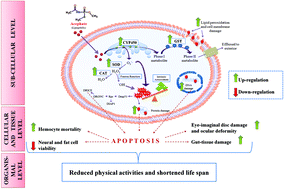Chronic exposure to acephate triggers ROS-mediated injuries at organismal and sub-organismal levels of Drosophila melanogaster
Abstract
The present study demonstrates ROS-mediated organismal and sub-organismal injuries in Drosophila melanogaster following chronic acephate exposure. Larvae and adults of Drosophila were reared on food supplemented with sub-lethal concentrations (1–6 μg mL−1) of acephate (LC50 8.71 μg mL−1). The longevity of the treated adults was reduced to half at 6 μg mL−1 exposure along with declined neuromuscular coordination and physical activities. Apparent developmental defects in the compound eyes were confirmed through the detection of apoptotic lesions in larval eye imaginal discs. The larval gut manifested tissue damage at various sites. Neural and fat cell viability was reduced by ∼1.89- and ∼3.38-fold at 6 μg mL−1 acephate treatment, respectively. A significant reduction in hemocyte viability confirmed the immunotoxic potential of acephate. Nearly 1–3-fold enhancement in the expression of OS markers (MDA, protein carbonyl contents, SOD, catalase and HSP70) in the treated larvae served as evidence of ROS production. The post-treatment increase in CYP450 and GST activities reflects the ‘switch-on’ states of the phase-I and phase-II detoxification mechanism. The genotoxic potential of acephate was confirmed through alkaline single cell gel electrophoresis. Thus, the findings of the present study validate the fact that besides traditional cholinesterase inhibition, chronic sub-lethal exposure to acephate potentially induces ROS-mediated toxic responses in Drosophila.



 Please wait while we load your content...
Please wait while we load your content...